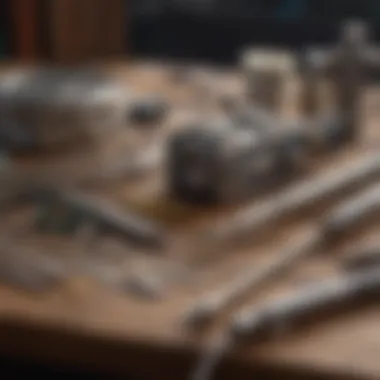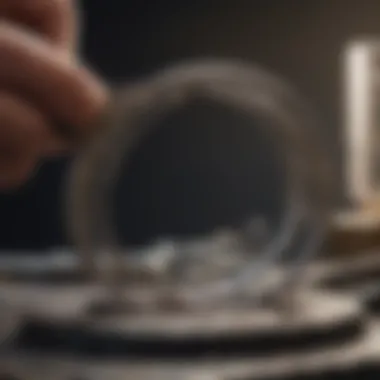Mastering the Art of Sterling Silver Wire Soldering: A Comprehensive Guide for Jewelry Enthusiasts and Professionals


In the realm of jewelry-making, the meticulous process of soldering sterling silver wire stands as a fundamental skill for both amateurs and professionals alike. This guide delves into the intricate nuances of this craft, equipping individuals with the knowledge and techniques required to create exquisite silver jewelry pieces that exude elegance and craftsmanship.
Selecting the Right Tools
Mastering the Technique
At the core of soldering sterling silver wire lies the mastery of technique. Achieving a strong and clean solder joint requires attention to detail and practice. The process involves aligning the silver pieces, applying flux, heating the metal evenly, and introducing the solder at the right moment. The solder should flow smoothly, creating a seamless bond between the wires. Practice and patience are key to honing this skill, leading to the creation of beautifully crafted silver jewelry.
Creating Stunning Jewelry Pieces
Through an understanding of the soldering process and mastery of technique, individuals can unleash their creativity and design unique silver jewelry pieces. From delicate earrings to intricate bracelets, the possibilities are endless. Each soldered joint represents a connection, a moment where precision and artistry converge to bring forth stunning and timeless creations in silver.
Synthesizing the Information
As individuals embark on their journey into the art of soldering sterling silver wire, they are not merely engaging in a craft but embracing a tradition and mastery that spans generations. By selecting the right tools, mastering the technique, and channeling creativity, artisans can transform raw materials into exquisite works of wearable art. This guide serves as a compass, leading enthusiasts and professionals alike towards the pinnacle of excellence in silver jewelry-making.
Introduction to Soldering Sterling Silver Wire
Soldering sterling silver wire is a craft that requires meticulous precision and expertise. Understanding the properties and nuances of sterling silver is paramount in achieving impeccable soldered joints. In this section, we will delve into the key elements that make soldering sterling silver wire a critical aspect of jewelry-making.
Understanding the Properties of Sterling Silver
Composition of Sterling Silver
The composition of sterling silver, typically containing 92.5% silver and 7.5% alloy metals such as copper, lends it durability and strength while retaining the lustrous appeal of silver. This composition ensures that the silver maintains its form and structure, making it an ideal choice for creating intricate jewelry pieces. Despite its susceptibility to tarnishing, proper care and soldering techniques can preserve the integrity of sterling silver jewelry.
Benefits of Using Sterling Silver in Jewelry Making
Utilizing sterling silver in jewelry-making offers a myriad of benefits. Its versatility allows for intricate designs and detailed craftsmanship while exuding an element of sophistication. Notably, sterling silver's affordability compared to other precious metals makes it a popular choice among jewelry artisans. Its malleability and durability enable artisans to create timeless pieces with enduring beauty, making it a staple in the world of jewelry design.


Importance of Soldering in Jewelry Making
Soldering serves as a fundamental technique in jewelry-making, offering a method to join metals securely without compromising their integrity. A clear distinction between soldering and welding lies in the application of heat; soldering uses lower temperatures, preventing damage to the delicate structure of sterling silver. This section explores the advantages of soldering sterling silver wire compared to welding, emphasizing its significance in crafting exquisite jewelry pieces.
Soldering vs. Welding
In the realm of jewelry-making, soldering trumps welding due to its precision and ability to create seamless joints without altering the composition of the metals. While welding may be suitable for certain applications, soldering is preferred when working with delicate materials like sterling silver to maintain their aesthetic and structural integrity.
Advantages of Soldering Sterling Silver Wire
Soldering sterling silver wire offers precision and control, ensuring seamless connections between components. The method allows artisans to create intricate designs with ease, making it a preferred choice for jewelry makers aiming for perfection in their creations. The flexibility of soldering techniques opens up a world of design possibilities, enabling artisans to bring their creative visions to life with unparalleled finesse.
Essential Tools and Materials
To embark on the journey of soldering sterling silver wire, a set of essential tools and materials are indispensable. These tools, such as the soldering iron or torch, flux and solder wire, and pickling solution, play a crucial role in ensuring successful soldered joints and impeccable craftsmanship.
Soldering Iron or Torch
The soldering iron or torch is the cornerstone of soldering sterling silver wire. Its ability to heat the soldering joint precisely is essential for achieving seamless connections. Choosing the right soldering iron or torch suited for sterling silver work is imperative to control the flow of heat and ensure the longevity of the jewelry piece.
Flux and Solder Wire
Pickling Solution
The pickling solution serves as a post-soldering treatment to remove oxidation and discoloration, restoring the brilliance of sterling silver. Properly applying the pickling solution ensures a clean finish on soldered joints while enhancing the overall aesthetic of the jewelry piece. Incorporating pickling into the soldering process is essential for maintaining the pristine quality of sterling silver jewelry.
Preparing Sterling Silver Wire for Soldering
In the realm of jewelry-making, preparing sterling silver wire for soldering is a critical step that cannot be overlooked. The cleanliness and condition of the silver wire directly impact the success and quality of the soldered joint. By meticulously cleaning and prepping the surface of the silver wire, artisans ensure a strong and durable bond between the pieces being joined. Not only does this enhance the overall aesthetic appeal of the final piece, but it also guarantees structural integrity and longevity.


Cleaning and Prepping the Surface
Importance of Surface Preparation
Surface preparation plays a pivotal role in the soldering process, especially when working with sterling silver wire. It involves removing any dirt, grease, or contaminants that could hinder the solder from properly adhering to the metal. The cleanliness of the surface is crucial for achieving a solid and seamless solder joint. Properly prepared surfaces promote efficient heat transfer, allowing the solder to flow smoothly and create a secure bond.
Removing Oxidation and Tarnish
Oxidation and tarnish are common issues faced when working with sterling silver wire. These surface imperfections not only detract from the visual appeal of the final piece but also create barriers to successful soldering. By eliminating oxidation and tarnish through methods like polishing or chemical cleaners, artisans ensure a clean and receptive surface for the solder. This meticulous approach guarantees that the solder can bind effectively with the silver wire, creating a flawless connection that withstands the test of time.
Flux Application
Types of Flux for Sterling Silver
When soldering sterling silver wire, selecting the right flux is crucial for achieving optimal results. Flux serves multiple purposes, such as preventing oxidation during the soldering process, promoting solder flow, and reducing surface tension for improved adhesion. Different types of flux are available, each tailored to specific applications and soldering requirements. Choosing the appropriate flux for sterling silver ensures successful soldering outcomes, minimal cleanup, and a professional finish.
Proper Flux Application Techniques
Applying flux correctly is as important as choosing the right type of flux. Proper flux application involves evenly coating the surfaces to be soldered, ensuring complete coverage for effective protection and solder flow. Techniques such as using a brush or dipping the pieces in flux require precision and attention to detail. By mastering flux application techniques, artisans can control the soldering process, prevent issues like overheating or incomplete solder flow, and achieve consistently high-quality results.
Mastering the Soldering Technique
In the realm of jewelry making, mastering the soldering technique is akin to acquiring a precious skill set that elevates the craft to a form of artistry. The process of soldering sterling silver wire demands precision, patience, and a deep understanding of the properties of the metal. At the core of mastering this technique is the ability to create seamless joins that appear invisible, yet hold with utmost strength. Achieving mastery in soldering not only enhances the aesthetics of the final piece but also ensures longevity and durability.
Joining Sterling Silver Wire
Creating a Secure Joint:
Creating a secure joint in sterling silver wire is a critical aspect of the soldering process. This involves aligning the ends of the wires perfectly and fusing them together using solder. The key characteristic of a secure joint lies in its ability to withstand tension and stress without compromising the connection. This method is favored for its reliability and aesthetic appeal, providing a seamless finish to jewelry pieces. The unique feature of a secure joint is its resistance to external forces, making it a preferred choice for intricate designs that require structural integrity.


Heating and Flowing Solder:
Heating and flowing solder play a vital role in the soldering process by facilitating the bonding of silver wires. The key characteristic of this step is the controlled application of heat to melt the solder, allowing it to flow into the joint and create a strong bond. This technique is favored for its precision and ability to create clean, smooth connections between silver elements. The unique feature of heating and flowing solder lies in its capacity to join pieces seamlessly while maintaining the integrity of the metal, ensuring a flawless finish to the jewelry piece.
Avoiding Common Mistakes
Overheating the Silver:
Overheating the silver during soldering can lead to detrimental effects on the metal, such as distortion, discoloration, or even structural weakness. The key characteristic of overheating is the irreversible damage it can cause to the silver, compromising the overall quality of the jewelry piece. Avoiding this mistake is crucial to maintaining the integrity of the metal and preserving its unique properties. The disadvantage of overheating the silver is the risk of rendering the piece unsalvageable, emphasizing the importance of precise temperature control during soldering.
Insufficient Solder Flow:
Insufficient solder flow occurs when there is not enough solder to create a strong bond between silver wires. The key characteristic of this mistake is the weak connection it produces, which can lead to potential breakage or detachment over time. Adequate solder flow is essential for ensuring the durability and longevity of the soldered joint. The disadvantage of insufficient solder flow is the compromised structural integrity of the jewelry piece, highlighting the significance of using the correct amount of solder to achieve reliable connections.
Finishing Touches and Clean-Up
In the realm of soldering sterling silver wire, the step of finishing touches and clean-up holds immense significance. After the delicate process of soldering, it is crucial to ensure that the final pieces not only look impeccable but also maintain the integrity of the silver wire. By embracing a meticulous approach to finishing touches and clean-up, artisans can elevate their creations to a professional level. The attention to detail in this phase guarantees that the jewelry pieces are not only structurally sound but also visually appealing, reflecting the precision and expertise of the craftsperson.
Quenching and Pickling
Quenching Process
When focusing on the quenching process in the context of soldering sterling silver wire, it is essential to highlight its pivotal role in tempering the metal. Quenching, a rapid cooling method, serves to enhance the hardness and durability of the silver wire after the soldering phase. The key characteristic of the quenching process lies in its ability to swiftly transform the heated silver into a hardened state, ensuring that the structural integrity of the jewelry piece is maintained. One notable advantage of quenching is its efficiency in setting the solder and preventing any potential deformations that may occur during the cooling process. However, a disadvantage of quenching is the risk of thermal shock, which may lead to cracks or brittleness in the silver wire.
Benefits of Pickling
Delving into the benefits of pickling unveils its significant contribution to the overall quality of soldered sterling silver wire. Pickling, a process involving the removal of oxides and flux residues through a chemical solution, plays a crucial role in refining the appearance of the silver jewelry piece. The key characteristic of pickling is its ability to restore the silver wire to its pristine state, eliminating any surface imperfections to reveal a lustrous finish. One of the primary benefits of pickling is its effectiveness in removing stubborn tarnish and oxidation, ensuring that the jewelry piece retains its brilliance. However, a potential drawback of pickling is its corrosive nature if not properly neutralized or rinsed, which may affect the longevity of the silver wire.
Polishing and Refining
Polishing Techniques
In the realm of soldering sterling silver wire, mastering effective polishing techniques is paramount to achieving a flawless finish. Polishing techniques involve the use of abrasive materials to smooth and buff the surface of the silver jewelry piece, enhancing its shine and overall aesthetic appeal. One key characteristic of polishing techniques is their ability to remove any surface imperfections or scratches, revitalizing the appearance of the silver wire. The unique feature of polishing techniques lies in their versatility, allowing artisans to choose from a variety of polishing tools and compounds to suit their specific requirements. While the advantages of polishing techniques include achieving a mirror-like finish and enhancing the jewelry piece's attractiveness, a potential disadvantage is the time and effort required to achieve a high level of polish.
Final Inspection
Conducting a thorough final inspection marks the culmination of the soldering process in creating sterling silver wire jewelry. The final inspection entails a detailed examination of the soldered joints, surface integrity, and overall presentation of the jewelry piece to ensure that it meets the desired standards of quality and craftsmanship. The key characteristic of final inspection is its role in verifying the structural integrity and aesthetic appeal of the finished product. By meticulously scrutinizing every aspect of the jewelry piece, artisans can identify any flaws or inconsistencies that may require further refinement. The unique feature of final inspection lies in its capacity to provide assurance of the jewelry piece's durability and visual allure, making it an indispensable step in the soldering process. While the advantages of final inspection include maintaining high quality standards and ensuring customer satisfaction, a potential disadvantage is the time-consuming nature of performing a comprehensive inspection.







